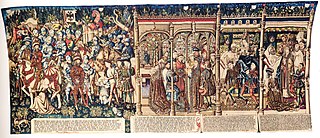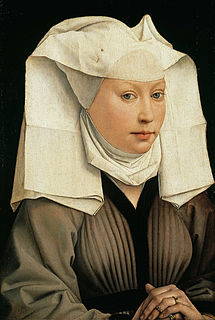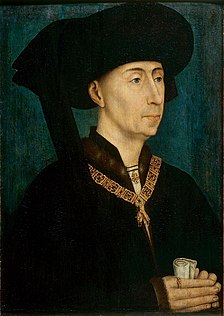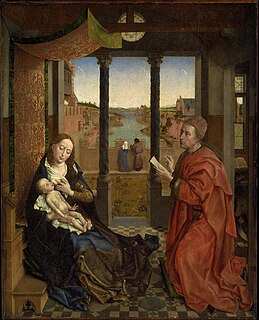 W
WThe Annunciation Triptych is an oil-on-panel triptych by the Netherlandish artist Rogier van der Weyden, dating from around 1434. It was originally formed by three panels, the central one being now at The Louvre museum in Paris, France; the side panels are at the Galleria Sabauda of Turin, northern Italy.
 W
WThe Beaune Altarpiece is a large polyptych c. 1445–1450 altarpiece by the Early Netherlandish artist Rogier van der Weyden, painted in oil on oak panels with parts later transferred to canvas. It consists of fifteen paintings on nine panels, of which six are painted on both sides. Unusually for the period, it retains some of its original frames.
 W
WThe Bladelin Altarpiece, or Middelburg Altarpiece, is a triptych painting created around 1450 by the Flemish painter Rogier van der Weyden, towards the end of his artistic career. The work depicts scenes relating to the birth of Jesus; it is the only nativity scene definitively attributed to van der Weyden, and so is also known as the Nativity Triptych. It was donated to the new church of the town of Middelburg in 1460, possibly by Pieter Bladelin, who founded the town. It has been in the Gemäldegalerie, Berlin, since 1834.
 W
WThe Braque Triptych is a c. 1452 oil-on-oak altarpiece by the Early Netherlandish painter Rogier van der Weyden. When open, its three half-length panels reveal, from left to right, John the Baptist, The Virgin Mary with Jesus and Saint John the Evangelist, and on the right, Mary Magdalene. When the wings are closed, the work shows a vanitas motif of a skull and cross.
 W
WChrist on the Cross with Mary and St John is a c.1443-1445 altarpiece by Rogier van der Weyden, now in the Kunsthistorisches Museum in Vienna. The central scene shows the Crucifixion of Jesus, with the Virgin Mary clinging to the foot of the cross, John the Evangelist comforting her and the painting's two donors kneeling to the right. On the left hand side panel is Mary Magdalene, whilst on the right side panel is St Veronica. A unified landscape background across all three panels shows Jerusalem in the distance.
 W
WCrucifixion Diptych — also known as Philadelphia Diptych, Calvary Diptych, Christ on the Cross with the Virgin and St. John, or The Crucifixion with the Virgin and Saint John the Evangelist Mourning — is a diptych by the Early Netherlandish artist Rogier van der Weyden, completed c. 1460, today in the Philadelphia Museum of Art. The panels are noted for their technical skill, visceral impact and for possessing a physicality and directness unusual for Netherlandish art of the time. The Philadelphia Museum of Art describes work as the "greatest Old Master painting in the Museum."
 W
WThe Descent from the Cross is a panel painting by the Flemish artist Rogier van der Weyden created c. 1435, now in the Museo del Prado, Madrid. The crucified Christ is lowered from the cross, his lifeless body held by Joseph of Arimathea and Nicodemus.
 W
WDurán Madonna is an oil on oak panel painting completed sometime between 1435 and 1438 by the Netherlandish painter Rogier van der Weyden. The painting derives from Jan van Eyck's Ince Hall Madonna and was much imitated subsequently. Now in the Prado, Madrid, it depicts a seated and serene Virgin Mary dressed in a long, flowing red robe lined with gold-coloured thread. She cradles the child Jesus who sits on her lap, playfully leafing backwards through a holy book or manuscript on which both figures' gazes rest. But unlike van Eyck's earlier treatment, van der Weyden not only positions his Virgin and Child in a Gothic apse or niche as he had his two earlier madonnas, but also places them on a projecting plinth, thus further emphasising their sculptural impression.
 W
WJean Wauquelin presenting his 'Chroniques de Hainaut' to Philip the Good is a presentation miniature believed to have been painted by the Flemish artist Rogier van der Weyden. It decorates the frontispiece to the Chroniques de Hainaut, MS KBR.9242, a translation from Latin into French of a three volume history in of the County of Hainaut by Jean Wauquelin. The Latin text was originally written by the 14th century Franciscan historian Jacques de Guyse.
 W
WThe Justice of Trajan and Herkinbald was a set of four large panels painted by the Flemish painter Rogier van der Weyden that decorated one wall of a court-room in the Town Hall of Brussels. They represented the Justice of Trajan, a Roman emperor, and the Justice of Herkinbald, a legendary Duke of Brabant. The panels were intended as a reminder to judges to dispense impartial justice and were admired by generations of visitors, including Albrecht Dürer. They were destroyed when the city was bombarded by the French in 1695 and are now known only from descriptions and from a tapestry copy in the Historical Museum of Bern.
 W
WThe Lamentation of Christ is an oil-on-panel painting of the common subject of the Lamentation of Christ by the Netherlandish artist Rogier van der Weyden, dating from around 1460–1463 and now in the Uffizi Gallery, Florence, Italy.
 W
WThe Madonna Standing is a small painting by the Flemish artist Rogier van der Weyden dating from about 1430–1432. It is the left panel of a diptych held in the Kunsthistorisches Museum (KHM), Vienna since 1772. The right panel portrays St. Catherine and is also attributed by the KHM to van der Weyden, but is inferior in quality and generally regarded as by a workshop member.
 W
WThe Magdalen Reading is one of three surviving fragments of a large mid-15th-century oil-on-panel altarpiece by the Early Netherlandish painter Rogier van der Weyden. The panel, originally oak, was completed some time between 1435 and 1438 and has been in the National Gallery, London since 1860. It shows a woman with the pale skin, high cheek bones and oval eyelids typical of the idealised portraits of noble women of the period. She is identifiable as the Magdalen from the jar of ointment placed in the foreground, which is her traditional attribute in Christian art. She is presented as completely absorbed in her reading, a model of the contemplative life, repentant and absolved of past sins. In Catholic tradition the Magdalen was conflated with both Mary of Bethany who anointed the feet of Jesus with oil and the unnamed "sinner" of Luke 7:36–50. Iconography of the Magdalen commonly shows her with a book, in a moment of reflection, in tears, or with eyes averted.
 W
WThe Medici Madonna is an oil-on-panel painting by the Netherlandish artist Rogier van der Weyden, dating from around 1460–1464 and housed in the Städel, Frankfurt, Germany.
 W
WThe Miraflores Altarpiece is a c. 1442-5 oil-on-oak wood panel altarpiece by the Early Netherlandish painter Rogier van der Weyden, in the Gemäldegalerie, Berlin since 1850. The three panels are each 71 x 43 cm and show, from left to right, a portrait of the Holy Family, a Pietà and Christ's appearance to Mary—a chronological reading of the birth, death and resurrection of Jesus, with Mary the focus of both wings. The altarpiece examines Mary's relationship with Christ at different stages of his life. It is notable for its use of colour, distinguished by its use of whites, reds and blues, and use of line—notably the line of Christ's body in the central panel—and, typically of van der Weyden, its emotional impact.
 W
WPietà is a painting by the Flemish artist Rogier van der Weyden dating from about 1441 held in the Royal Museums of Fine Arts of Belgium, Brussels. There are number of workshop versions and copies, notably in the National Gallery, London, in the Prado, Madrid, and in the Manzoni Collection, Naples. Infra-red and X-radiograph evidence suggest that the Brussels version was painted by van der Weyden himself, not necessarily excluding the help of workshop assistants. Dendrochronological analysis gives a felling date of 1431 for the oak panel backing, supporting the dating of the painting to around 1441.
 W
WPortrait of a Lady is a small oil-on-oak panel painting executed around 1460 by the Netherlandish painter Rogier van der Weyden. The composition is built from the geometric shapes that form the lines of the woman's veil, neckline, face, and arms, and by the fall of the light that illuminates her face and headdress. The vivid contrasts of darkness and light enhance the almost unnatural beauty and Gothic elegance of the model.
 W
WPortrait of a Young Woman is a drawing by the Flemish artist Rogier van der Weyden. It depicts a young woman wearing a headscarf pinned to her hair and has been variously dated as c. 1430s and c. 1440 - 1445. The identity of the woman has not been established, nor her social class. The drawing is presumably a study for a painted portrait now lost, but likely to have been similar to the Portrait of a Woman in Berlin.
 W
WPortrait of a Young Woman is a painting completed between 1435–1440 by the Netherlandish artist Rogier van der Weyden. The sitter in this small work wears a wide, white hennin over a brown dress, which features a black-lined, v-shaped neckline. As is usual of van der Weyden's female portraits, her hands are clasped tightly in prayer, while her expression is generally humble. Unusually for a van der Weyden', she does not bow her head or gaze into the middle distance. Instead she looks directly at the viewer, creating an intimate relationship between sitter, viewer and artist, which art historian and research curator Lorne Campbell describes as "appealing and vibrant".
 W
WPortrait of Antoine, 'Grand Bâtard' of Burgundy is an oil panel painting by the Netherlandish painter Rogier van der Weyden portraying Anthony of Burgundy, the bastard son of Philip the Good and one of his mistresses, Jeanne de Presle. The panel is dated to about 1460 and held in the Royal Museums of Fine Arts of Belgium, Belgium. He wears the livery collar of Order of the Golden Fleece, a chivalric order established January 10, 1430, by Philip the Good, Duke of Burgundy. In 1456 Anthony was inducted into the prestigious Order, held by only 29 others at that time. The exact significance of the arrow held in the bastard's hand is unknown, although the fleece is thought to refer to either the Greek mythological hero Jason or the Hebrew warrior and judge Gideon.
 W
WPortrait of Francesco d'Este is a small oil on wood panel painting by the Netherlandish painter Rogier van der Weyden dating to around 1460. The work is in good condition and has been in the Metropolitan Museum of Art, New York since 1931. When attributed as a van der Weyden in the early 20th century, there was much speculation amongst art historians as to the sitter's identity. He was identified as a member of the d'Este family from the crest on the reverse, and long thought to be Francesco's father Lionello, an Italian and highly placed Burgundian prince and patron of Rogier. In 1939 Ernst Kantorowicz identified the man as Lionello's illegitimate son Francesco, which is now generally accepted. The panel was painted when the sitter was about 30 years old and is considered one of van der Weyden's finest portraits, in many ways a culmination of his later, more austere work.
 W
WThe Portrait of Isabella of Portugal is an oil-on-oak Early Netherlandish painting of Isabella of Portugal, Duchess of Burgundy, the third wife of Philip the Good. Executed around 1450, the painting had been attributed to Rogier van der Weyden, but is now believed to be from a member of his workshop.
 W
WThe Diptych of Philip de Croÿ with The Virgin and Child consists of a pair of small oil-on-oak panels painted c. 1460 by the Netherlandish artist Rogier van der Weyden. While the authorship and dating of both works are not in doubt, it is believed but not proven that they were created as wings of a devotional diptych and that at some unknown time the panels were broken apart. A diptych panel fitting the description of the Mary wing was described in a 1629 inventory of paintings owned by Alexandre d'Arenberg, a descendant of Philip I de Croÿ (1435–1511). Both have been approximately dated to 1460 and are now in Antwerp and San Marino, CA respectively. The reverse of de Croÿ's portrait is inscribed with the family crest and the title used by the sitter from 1454 to 1461.
 W
WPortrait of Philip the Good is a lost oil on wood panel painting by the Early Netherlandish painter Rogier van der Weyden, dated variously from the mid 1440s to sometime after 1450.
 W
WThe Saint Columba Altarpiece is a large c. 1455 oil-on-oak wood panel altarpiece by Early Netherlandish painter Rogier van der Weyden, now in the Alte Pinakothek, Munich.
 W
WThe Saint Hubert Altarpiece was a late 1430s altarpiece in the Chapel of St Hubert in the church of St Gudule, Brussels by Rogier van der Weyden and his studio. Its central image is lost but its side panels are thought to be The Dream of Pope Sergius and The Exhumation of St Hubert - In around 1623 Dubuisson-Aubenay recorded seeing a two-part painting in that church which matches the description of these two panels.
 W
WSt. Jerome and the Lion is an oil on oak panel painting by Rogier van der Weyden or his studio from c. 1450–1465, showing Jerome and a lion. It is now in the Detroit Institute of Arts. This painting also inspired a genre of St. Jerome art.
 W
WSaint Luke Drawing the Virgin is a large oil and tempera on oak panel painting, usually dated between 1435 and 1440, attributed to the Early Netherlandish painter Rogier van der Weyden. Housed in the Museum of Fine Arts, Boston, it shows Luke the Evangelist, patron saint of artists, sketching the Virgin Mary as she nurses the Child Jesus. The figures are positioned in a bourgeois interior which leads out towards a courtyard, river, town and landscape. The enclosed garden, illusionistic carvings of Adam and Eve on the arms of Mary's throne, and attributes of St Luke are amongst the painting's many iconographic symbols.
 W
WThe Seven Sacraments Altarpiece is a fixed-wing triptych by the Early Netherlandish artist Rogier van der Weyden and his workshop. It was painted from 1445 to 1450, probably for a church in Poligny, and is now in the Royal Museum of Fine Arts, Antwerp. It depicts the seven sacraments of the Roman Catholic Church. On the left panel are baptism, confirmation and confession and on the right hand panel the ordination of a priest, marriage and the last rites.
 W
WThe St John Altarpiece is a c. 1455 oil-on-oak wood panel altarpiece by the Early Netherlandish painter Rogier van der Weyden, now in the Gemäldegalerie, Berlin. The triptych is linked to the artist's earlier Miraflores Altarpiece in its symbolic motifs, format and intention.
 W
WThe Virgin and Child is a painting by the Flemish artist Rogier van der Weyden dating from after 1454 in the collection of the Museum of Fine Arts, Houston.
 W
WThe Virgin and Child Enthroned is a small oil-on-oak panel painting dated c. 1433, usually attributed to the Early Netherlandish artist Rogier van der Weyden. It is closely related to his Madonna Standing, completed during the same period. The panel is filled with Christian iconography, including representations of prophets, the Annunciation, Christ's infancy and resurrection, and Mary's Coronation. It is generally accepted as the earliest extant work by van der Weyden, one of three works attributed to him of the Virgin and Child enclosed in a niche on an exterior wall of a Gothic church. The panel is housed in the Museo Thyssen-Bornemisza in Madrid.
 W
WVirgin and Child with Saints, is a large mid-15th century oil-on-oak altarpiece by the early Netherlandish painter Rogier van der Weyden. The work is lost since at least the 17th century, known only through three surviving fragments and drawing of the full work in Stockholm's Nationalmuseum by a follower of van der Weyden. The drawing is sometimes attributed to the Master of the Drapery Studies.
 W
WVisitation is a c.1445 oil on panel painting of the Visitation by Rogier van der Weyden, now in the Museum der bildenden Künste in Leipzig. It is linked to Luke 1:40.